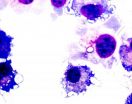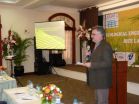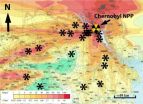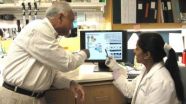(Press-News.org) Scientists working on the world's leading particle collider experiments have joined forces, combined their data and produced the first joint result from Fermilab's Tevatron and CERN's Large Hadron Collider (LHC), past and current holders of the record for most powerful particle collider on Earth.
Scientists from the four experiments involved—ATLAS, CDF, CMS and DZero—announced their joint findings on the mass of the top quark on March 19, 2014 at the Rencontres de Moriond international physics conference in Italy.
Together the four experiments pooled their data analysis power to arrive at a new world's best value for the mass of the top quark of 173.34 plus/minus 0.76 GeV/c2.
Experiments at the LHC at the CERN laboratory in Geneva, Switzerland and the Tevatron collider at Fermilab near Chicago in Illinois, USA are the only ones that have ever seen top quarks—the heaviest elementary particles ever observed. The top quark's huge mass (more than 100 times that of the proton) makes it one of the most important tools in the physicists' quest to understand the nature of the universe.
The new precise value of the top-quark mass will allow scientists to test further the mathematical framework that describes the quantum connections between the top quark, the Higgs particle and the carrier of the electroweak force, the W boson. Theorists will explore how the new, more precise value will change predictions regarding the stability of the Higgs field and its effects on the evolution of the universe. It will also allow scientists to look for inconsistencies in the Standard Model of particle physics – searching for hints of new physics that will lead to a better understanding of the nature of the universe.
"The combining together of data from CERN and Fermilab to make a precision top quark mass result is a strong indication of its importance to understanding nature," said Fermilab director Nigel Lockyer. "It's a great example of the international collaboration in our field."
A total of more than six thousand scientists from more than 50 countries participate in the four experimental collaborations. The CDF and DZero experiments discovered the top quark in 1995, and the Tevatron produced about 300,000 top quark events during its 25-year lifetime, completed in 2011. Since it started collider physics operations in 2009, the LHC has produced close to 18 million top quarks, making it the world's leading top quark factory.
"Collaborative competition is the name of the game," said CERN's Director General Rolf Heuer. "Competition between experimental collaborations and labs spurs us on, but collaboration such as this underpins the global particle physics endeavour and is essential in advancing our knowledge of the universe we live in."
Each of the four collaborations previously released their individual top-quark mass measurements. Combining them together required close collaboration between the four experiments, understanding in detail each other's techniques and uncertainties. Each experiment measured the top-quark mass using several different methods by analysing different top quark decay channels, using sophisticated analysis techniques developed and improved over more than 20 years of top quark research beginning at the Tevatron and continuing at the LHC.
The joint measurement has been submitted to the electronic arXiv.
INFORMATION:
CERN, the European Organization for Nuclear Research, is the world's leading laboratory for particle physics. It has its headquarters in Geneva. At present, its member states are Austria, Belgium, Bulgaria, the Czech Republic, Denmark, Finland, France, Germany, Greece, Hungary, Israel, Italy, the Netherlands, Norway, Poland, Portugal, Slovakia, Spain, Sweden, Switzerland and the United Kingdom. Romania is a candidate for accession. Serbia is an associate member in the pre-stage to membership. India, Japan, the Russian Federation, the United States of America, Turkey, the European Commission and UNESCO have observer status.
Fermilab is America's national laboratory for particle physics research. A U.S. Department of Energy Office of Science laboratory, Fermilab is located near Chicago, Illinois, and operated under contract by the Fermi Research Alliance, LLC. Visit Fermilab's website at http://www.fnal.gov and follow us on Twitter at @FermilabToday. To learn more about the DOE's Office of Science, visit http://science.energy.gov.
The ATLAS and CMS experiments are international collaborations of universities and research labs, supported by funding agencies around the world. Information about the experiments, including their collaborating institutions, can be found at http://atlas.ch and http://cern.ch/cms.
Funding for the CDF and DZero experiments comes from numerous international funding agencies, including the U.S. Department of Energy's Office of Science and the U.S. National Science Foundation. View a list of CDF's collaboration institutions at http://www-cdf.fnal.gov/collaboration/index.html, and DZero's list at http://www-d0.fnal.gov/ib/Institutions.html.
International team of LHC and Tevatron scientists announces first joint result
2014-03-19
ELSE PRESS RELEASES FROM THIS DATE:
Social feedback loop aids language development
2014-03-19
Verbal interactions between parents and children create a social feedback loop important for language development, according to research forthcoming in Psychological Science, a journal of the Association for Psychological Science. That loop appears to be experienced less frequently and is diminished in strength in interactions with autistic children.
"This loop likely has cascading impacts over the course of a child's development," says psychological scientist and study author Anne S. Warlaumont of the University of California, Merced. "Understanding how it works and ...
Geosphere presents articles examining lithospheric evolution and geologic history
2014-03-19
Boulder, Colo., USA – Geosphere articles posted online 17 Mar. 2014 include additions to two series: "CRevolution 2: Origin and Evolution of the Colorado River System II" and "Origin and Evolution of the Sierra Nevada and Walker Lane." Other articles present new seismic data for the Slate Range of California, USA; the first detailed geologic map from the Likhu Khola region of east central Nepal; and a review of pre-21st century ideas about the origin of Grand Canyon.
Abstracts for these and other Geosphere papers are available at http://geosphere.gsapubs.org/. Representatives ...
Low doses of antianxiety drugs rebalance the autistic brain
2014-03-19
New research in mice suggests that autism is characterized by reduced activity of inhibitory neurons and increased activity of excitatory neurons in the brain, but balance can be restored with low doses of a well-known class of drugs currently used in much higher doses to treat anxiety and epileptic seizures. The findings, which are reported in the March 19th issue of the Cell Press journal Neuron, point to a new therapeutic approach to managing autism.
"These are very exciting results because they suggest that existing drugs—called benzodiazepines—might be useful in ...
Fetal Alcohol Spectrum Disorders (FASD): An under-recognized issue that may be on the rise
2014-03-19
March 19, 2014 – The open-access International Journal of Alcohol and Drug Research has released a special issue on Fetal Alcohol Spectrum Disorders (FASD), with the intention of increasing awareness of the negative effects of alcohol use in pregnancy and improving prevention, treatment and care for those living with FASD.
"In most countries, FASD is not well recognized by health professionals," says guest editor Dr. Svetlana (Lana) Popova, Senior Scientist in the Social and Epidemiological Research Department at the Centre for Addiction and Mental Health (CAMH). "If ...
Study describes first maps of neural activity in behaving zebrafish
2014-03-19
In a study published today (19/3/2014) in the scientific journal Neuron, neuroscientists at the Champalimaud Foundation, in collaboration with neuroscientists from Harvard University, describe the first activity maps at the resolution of single cells and throughout the entire brain of behaving zebrafish.
"This opens up new possibilities for studying neural circuits in the brain," says Michael Orger, principal investigator at the Champalimaud Neuroscience Programme. "In order to understand how the brain works, it is imperative that we can record the activity of the cells ...
Researchers uncover allergy-cancer connection
2014-03-19
While many are stocking up on allergy medicine in preparation for spring, a new study from researchers at Virginia Commonwealth University Massey Cancer Center has uncovered a new connection between allergy and cancer that could potentially lead to therapies involving common antihistamines.
Recently published in the Journal of Leukocyte Biology, the study was led by Daniel H. Conrad, Ph.D., member of the Cancer Cell Signaling research program at Massey and professor of microbiology and immunology at the VCU School of Medicine, with substantial contributions from Ph.D. ...
Growing rice the sustainable way: LEGATO holds its 3rd annual conference
2014-03-19
In a world facing the challenges of climate change, demographic boom and deficit in food resources, the word "sustainable" and the concept behind it become increasingly relevant. Sustainability in the way humanity uses available resources is key to a brighter and greener future.
In the context of sustainable food production, there is a clear need for crop productivity increases and diversification. Optimising rice ecosystem functions and services in Southeast Asia and their stabilisation under future land use and climate change, is the main focus of the project LEGATO ...
Radiation damage at the root of Chernobyl's ecosystems
2014-03-19
Radiological damage to microbes near the site of the Chernobyl disaster has slowed the decomposition of fallen leaves and other plant matter in the area, according to a study just published in the journal Oecologia. The resulting buildup of dry, loose detritus is a wildfire hazard that poses the threat of spreading radioactivity from the Chernobyl area.
Tim Mousseau, a professor of biology and co-director of the Chernobyl and Fukushima Research Initiatives at the University of South Carolina, has done extensive research in the contaminated area surrounding the Chernobyl ...
Research reveals true value of cover crops to farmers, environment
2014-03-19
Planting cover crops in rotation between cash crops -- widely agreed to be ecologically beneficial -- is even more valuable than previously thought, according to a team of agronomists, entomologists, agroecologists, horticulturists and biogeochemists from Penn State's College of Agricultural Sciences.
"As society places increasing demands on agricultural land beyond food production to include ecosystem services, we needed a new way to evaluate 'success' in agriculture," said Jason Kaye, professor of biogeochemistry. "This research presents a framework for considering ...
Researchers identify potential new therapeutic target for controlling high blood sugar
2014-03-19
DALLAS – March 19, 2014 – A UT Southwestern Medical Center study has identified a new potential therapeutic target for controlling high blood sugar, a finding that could help the estimated 25 million Americans with type 2 diabetes.
Researchers showed that lipid molecules called phosphatidic acids enhance glucose production in the liver. These findings suggest that inhibiting or reducing production of phosphatidic acids may do the opposite.
“This study establishes a role for phosphatidic acids in enhancing glucose production by the liver and identifies enzymes involved ...





